 At some point, we all must follow a path we do not fully comprehend. It happened to Odysseus, Lord knows it happened to Abraham and, I suspect, Brad Pitt is familiar with the concept. So it came as no surprise when Maria Grazia Cucinotta, the Sicilian Goddess of…anything she wants to be, came to me in a dream and told me to buy a 325 WSM. Actually, she said, “Joseph, you stud,” her words, not mine, “buy a 325 WSM. It is faster than the 8mm Mauser, faster than the 8mm Remington Magnum and it won’t put you to sleep like a 30-06 Springfield or 308 Winchester”. Does that Maria know what she is talking about, or what? And then she said, just before my wife forehead slapped me into consciousness for smiling excessively in my sleep, “The secret is in the bullet”. Well, what could I do ? I became the proud owner of: a Browning Composite Stalker, an applicable set of Lee reloading dies and a collection of question marks in search of answers. One thing I knew about Winchester Short Magnum cartridges, based on prior experience, was that each has its own personality when it comes to performance and purpose. Experience with one would not predict acceptability or mediocrity of another…and then, as Maria pointed out, bullet selection is critical.
At some point, we all must follow a path we do not fully comprehend. It happened to Odysseus, Lord knows it happened to Abraham and, I suspect, Brad Pitt is familiar with the concept. So it came as no surprise when Maria Grazia Cucinotta, the Sicilian Goddess of…anything she wants to be, came to me in a dream and told me to buy a 325 WSM. Actually, she said, “Joseph, you stud,” her words, not mine, “buy a 325 WSM. It is faster than the 8mm Mauser, faster than the 8mm Remington Magnum and it won’t put you to sleep like a 30-06 Springfield or 308 Winchester”. Does that Maria know what she is talking about, or what? And then she said, just before my wife forehead slapped me into consciousness for smiling excessively in my sleep, “The secret is in the bullet”. Well, what could I do ? I became the proud owner of: a Browning Composite Stalker, an applicable set of Lee reloading dies and a collection of question marks in search of answers. One thing I knew about Winchester Short Magnum cartridges, based on prior experience, was that each has its own personality when it comes to performance and purpose. Experience with one would not predict acceptability or mediocrity of another…and then, as Maria pointed out, bullet selection is critical.
The 325 WSM…ad nauseam
When Winchester began cranking out short magnum cartridges like Gummi Bears, in the sputtering cross wake of Remington cranking out even shorter magnums like…other Gummi Bears, I distinctly remember thinking, “Can we ever have enough short fat slow moving cartridges?”. In retrospect, based upon lack of market acceptance, the answer to my rhetorical question is “Yes”. If you’re looking for a Remington 7mm or 300 SAUM, you’ll find them on the shelf next to the hen’s teeth. Winchester’s WSM series, however, seems to be faring a bit better. The 300 WSM holds the high ground with at least seven companies chambering for the round. The 270 WSM holds the next slot with nearly the same. The 300 WSM was introduced when the world was riding the crest of short magnum wacky. The 270 WSM’s success was partially due to the popularity wave, but also because of a lack of competing .277″ cartridges and the round’s genuinely excellent field performance.
The 7mm WSM and 325 WSM didn’t fare as well. By the time these products hit the retail shelves, the market was already witnessing the pin dropping silence of consumers not beating a path to Remington dealers in search of the SAUM chambered rifles. Additionally, real world experience and observed ho-hum performance of some short cartridges flew in stark contrast to the sales pitch – “More power, less recoil”. The most destructive influence, I believe, was Winchester when it pulled the plug on the Model 70 shortly after the 7mm and 325 WSM were released, and triggered an instant obsolescence scare. It is one thing for a customer to risk hard earned dollars on a rifle chambered for a new cartridge, but quite another to compound the risk when the manufacturer has publicly abandoned its own product.
Does the 325 WSM deserve consideration ?
Sure. There is good utility in a rifle that can convincingly be used on anything from deer through elk and moose and maybe large bear… for those not convinced something upward of a 375 H&H would be necessary for the latter task. The 200 grain 325 WSM can flat outshoot the 338 Winchester Mag at any range. The 220 – 225 grain bullet comparison isn’t so straight forward. Factory ammo puts the 325 WSM ahead of the 338 Winchester Magnum at the muzzle in both velocity and energy, but the 338 WM overtakes the 325 WSM before the hundred yard marker and retains an additional 500 ft/lbs of kinetic energy at 500 yards. I believe there is a remedy for this problem as Winchester loads the 338 WM with a very slick bullet with a ballistic coefficient of .549 while the 325 WSM gets saddled with a flying box car .388 B.C. slug. If I can come up with a B.C. for the 220 grain 325 WSM close to the Winchester 338 WM load, it would exceed 338 WM performance in a more mild mannered, compact, package. For lighter game like deer, 175 grains at 3100+ fps, 150 grain even higher, doesn’t seem a stretch. The 325 WSM could be a great all purpose cartridge.
| Cartridge | Distance – Yards | ||||||||
| Factory Load | Bullet – grains | BC | Performance | Muzzle | 100 | 200 | 300 | 400 | 500 |
| 325 Winchester Short Magnum | 180 | .438 | Ft/ps | 3060 | 2841 | 2632 | 2432 | 2242 | 2060 |
| Ft/Lbs | 373 | 3226 | 2769 | 2365 | 2009 | 1696 | |||
| 325 Winchester Short Magnum | 200 | .477 | Ft/ps | 2950 | 2753 | 2565 | 2384 | 2210 | 2044 |
| Ft/Lbs | 3866 | 3367 | 2922 | 2524 | 2170 | 1856 | |||
| 325 Winchester Short Magnum | 220 | ..388 | Ft/ps | 2840 | 2605 | 2382 | 2169 | 1968 | 1779 |
| Ft/Lbs | 3941 | 3316 | 2772 | 2300 | 1893 | 1547 | |||
| 8mm Remington Magnum | 200 | .332 | Ft/ps | 2900 | 2623 | 2361 | 2115 | 1885 | 1672 |
| Ft/Lbs | 3734 | 3054 | 2476 | 1987 | 1577 | 1241 | |||
| 338 Winchester Magnum | 200 | .308 | Ft/ps | 2960 | 2658 | 2375 | 2110 | 1862 | 1635 |
| Ft/Lbs | 3890 | 3137 | 2505 | 1977 | 1539 | 1187 | |||
| 338 Winchester Magnum | 200 | .414 | Ft/ps | 2950 | 2724 | 2509 | 2303 | 2108 | 1922 |
| Ft/Lbs | 3864 | 3294 | 2794 | 2355 | 1972 | 1640 | |||
| 338 Winchester Magnum | 225 | .549 | Ft/ps | 2800 | 2634 | 2474 | 2319 | 2170 | 2026 |
| Ft/Lbs | 3918 | 3467 | 3058 | 2688 | 2353 | 2052 | |||
| 338 Winchester Magnum | 230 | .436 | Ft/ps | 2780 | 2573 | 2375 | 2186 | 2005 | 1834 |
| Ft/Lbs | 3948 | 3382 | 2881 | 2441 | 2054 | 1710 | |||
Mighty Mouse…

The 325 WSM (drawing left) is derived from the old 404 Jeffery cartridge; dramatically shortened and necked down. Net capacity, below the neck is approximately 74 grains. WSMs are quite short, quite chunky, but they feed without hesitation (sort of like me) and they are quite easy to handload. The limiting dimension is their short maximum COL that makes getting heavy/long bullets to fly fast a problem, as they end up being seated deeply and robbing case capacity. One the bullet type I passed on, specifically for this reason, was the Barnes Triple Shock. They are long for their weight in the absence of lead content, and their BC isn’t exciting. If Barnes was still making their solid shank dry lube bullets I might have loaded some.
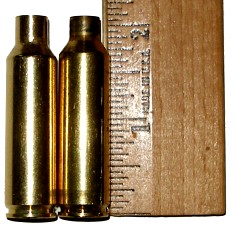 The 325 WSM (left case), when measured at the onset of the shoulder, is the same height as all of the other WSM’s, with the exception of the 7mm WSM (right case). Within a cartridge family, the neck generally needs to be a caliber equivalent in length for proper bullet support and retention. As the caliber increases, the neck length increases, causing the termination of the shoulder to be pushed back in the direction of the case head. Gross case capacity is usually increased as the neck diameter is increased, however, net capacity below the neck is somewhat reduced. The 7mm WSM has a shoulder height approximately 0.032″ higher than the 325 WSM. Winchester’s explanation, just before it left for Europe, is that this WSM design anomaly was necessary to prevent chambering the 7mm WSM in a 270 WSM chamber. That sounds silly, but the size difference is a tradition that dates back at least to the 270 Winchester – 280 Remington cartridges and, with the record number of nail gun injuries sustained by amateur do it yourselfers, probably a prudent step.
The 325 WSM (left case), when measured at the onset of the shoulder, is the same height as all of the other WSM’s, with the exception of the 7mm WSM (right case). Within a cartridge family, the neck generally needs to be a caliber equivalent in length for proper bullet support and retention. As the caliber increases, the neck length increases, causing the termination of the shoulder to be pushed back in the direction of the case head. Gross case capacity is usually increased as the neck diameter is increased, however, net capacity below the neck is somewhat reduced. The 7mm WSM has a shoulder height approximately 0.032″ higher than the 325 WSM. Winchester’s explanation, just before it left for Europe, is that this WSM design anomaly was necessary to prevent chambering the 7mm WSM in a 270 WSM chamber. That sounds silly, but the size difference is a tradition that dates back at least to the 270 Winchester – 280 Remington cartridges and, with the record number of nail gun injuries sustained by amateur do it yourselfers, probably a prudent step.
The best way to put the 325 WSM into performance context is recognize it is an 8mm placed well above the 8x57mm Mauser, above the 8mmx68s and above the 8mm Remington Magnum, even with the 8mm Remington Magnums 86 grain capacity. They are all, of course, .323″ caliber cartridges. I read…someplace, that the big drawback to the 325 WSM is a lack of bullets. I’m not sure where that comes from as I was easily able to find bullets from 125 grains to 220 grains intended for the cartridge’s velocity, its probable impact velocity and for use on a broad cross section of game. The more I researched, the more I liked the cartridge and its potential.
The Browning Composite Stalker…no slouch either
 My original search for a 325 WSM quickly ended at the intersection of “No Place” and “Not going to happen”. I couldn’t find a good Model 70 with a 325 WSM chamber; the FN holding company in Belgium had already discontinued the manufacturer of Winchester proprietary rifles and surviving examples were either nonexistence or of an odd configuration. the FN Browning guns chambered for this cartridge were not yet in production, or at least they were not in the inventory pipeline. I tried to talk myself into a $1,200 Kimber M8400 WSM synthetic on three occasions, but the dove gray stock made the rifle look toy gun cheap, feel off balance and settle in the hand muzzle heavy. Savage was offering models chambered for the 325 WSM but, based on prior experience, I am not a big fan of that particular brand. I set the project aside then, months later, ran across 325 WSM Browning specs and images while researching firearms and thought The Composite Stalker might make a good project gun.
My original search for a 325 WSM quickly ended at the intersection of “No Place” and “Not going to happen”. I couldn’t find a good Model 70 with a 325 WSM chamber; the FN holding company in Belgium had already discontinued the manufacturer of Winchester proprietary rifles and surviving examples were either nonexistence or of an odd configuration. the FN Browning guns chambered for this cartridge were not yet in production, or at least they were not in the inventory pipeline. I tried to talk myself into a $1,200 Kimber M8400 WSM synthetic on three occasions, but the dove gray stock made the rifle look toy gun cheap, feel off balance and settle in the hand muzzle heavy. Savage was offering models chambered for the 325 WSM but, based on prior experience, I am not a big fan of that particular brand. I set the project aside then, months later, ran across 325 WSM Browning specs and images while researching firearms and thought The Composite Stalker might make a good project gun.
I liked the Browning Composite Stalker the minute it was handed to me in its shipping carton. My Browning A-Bolt weighs just 6½ lbs with promotional tags and new gun preservative still in place. Aesthetically, it is a pretty rifle; narrow graceful stock lines and slender barrel taper, sweeping angled pancaked bolt handle, hex cut receiver, uniformly finished matte metal parts, and just the right gray-black graphite colored composite stock with a neat fitting resilient recoil pad. The Browning has an incredibly natural point and it’s dimensions and proportions make it exceptionally steady to hold on target. I don’t mean to sound overly exuberant, it’s just that getting my hands on a rifle I can really get excited about is approximately a 1 in 20 occurrence.
A little more detail…
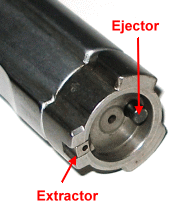 The Browning A bolt is a push feed action, the cartridge is not picked up and held by a Mauser type claw extractor as it is stripped from the magazine and pushed forward into the chamber. The case head is enclosed in the recessed bolt face and grabbed by the extractor as it is driven home. Works for me, and well. The bolt sleeve is non-rotating. There are three large locking lugs, each of a width that results in only 60° of rotation to lock/unlock. A case head is fully enclosed when the action is locked up, the small extractor claw and ejector rod are visible on the bolt face. Despite the fact the rifle us chambered for a good size cartridge with quite a bit of punch, the Browning feels like my little Model 7 chambered for the .223 Remington. I believe this is the result of the gun’s very light weight, abbreviated bolt rotation and fore and aft travel of only 3½”.
The Browning A bolt is a push feed action, the cartridge is not picked up and held by a Mauser type claw extractor as it is stripped from the magazine and pushed forward into the chamber. The case head is enclosed in the recessed bolt face and grabbed by the extractor as it is driven home. Works for me, and well. The bolt sleeve is non-rotating. There are three large locking lugs, each of a width that results in only 60° of rotation to lock/unlock. A case head is fully enclosed when the action is locked up, the small extractor claw and ejector rod are visible on the bolt face. Despite the fact the rifle us chambered for a good size cartridge with quite a bit of punch, the Browning feels like my little Model 7 chambered for the .223 Remington. I believe this is the result of the gun’s very light weight, abbreviated bolt rotation and fore and aft travel of only 3½”.
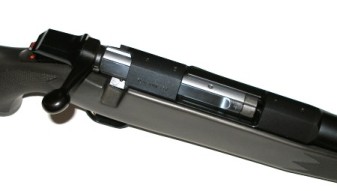 The action is smooth and generally closed to the elements. The bolt shroud is streamlined and the bolt handle is canted outward for an easy grab; both appear to be powder coated, the only aesthetic affront to my tastes. The tang safety is positive. The receiver is of course drilled and tapped for mounts. Browning will personalize the bolt with an owner identifier. Sort of like your Mom sewing a name tag in your underwear before sending you off to camp.
The action is smooth and generally closed to the elements. The bolt shroud is streamlined and the bolt handle is canted outward for an easy grab; both appear to be powder coated, the only aesthetic affront to my tastes. The tang safety is positive. The receiver is of course drilled and tapped for mounts. Browning will personalize the bolt with an owner identifier. Sort of like your Mom sewing a name tag in your underwear before sending you off to camp.
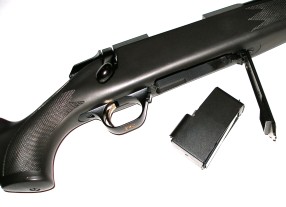
The hinged floorplate holds a detachable magazine that can be loaded with the floorplate open or through the top when the bolt is open. The Stalker holds 3 rounds of 325 WSM, 4 with one in the chamber. Extra magazines can be ordered from Browning and other sources for approximately $60, or about $15 more than a Remington M700 detachable magazine; capitalism in action. The stock, guard and floorplate assemblies are secured with two large graded cross slot fasteners and one small sheet metal Philips head screw at the leading end of the trigger guard; a little ugly, but more than sufficient for the task.
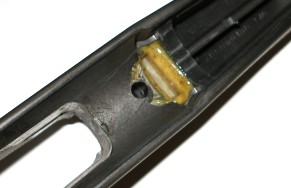
The Browning stock is a lightweight work of art; closely inletted around the action, hollow but ribbed and triangulated where appropriate. It weighs only 1¾ lbs, just a ¼ lb more than the old Super Shadow Winchester stocks, but certainly a lot nicer. The barrel is floated, however the recoil lug at the intersection of barrel and receiver is glass bedded to the stock. The checkering is credible, the recoil pad is 1⅝” wide, magnum width but perhaps a little rigid. I would rank the stock quality head and shoulders above a Howa Hogue, slightly below a Weatherby Mark V.
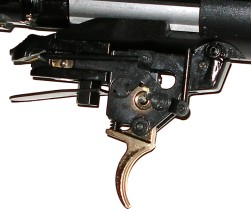
While the top of the top of the receiver suggest it is hexagonal in shape, only the tip is cut at angles with three flats, the bottom surface of the action is half round like a Remington M700. Rotation is checked by the action screws and glass bedded recoil lug.
The trigger assembly is pretty straight forward, clean in release and predictable with a chrome plated sear. The trigger pull, as received, was measured as a consistent 3¾ lbs with a digital trigger pull scale. Trigger pull is owner adjustable from 3.5 to 6 lbs. As with most production rifles, there is no over travel or sear engagement adjustment. Pull is set via a vertical Allen head adjuster directly behind the trigger, accessed by removing the trigger guard.
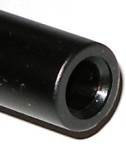
The hammer forged 23″ barrel is clean with 1:10″ twist. it is a lightweight barrel not unlike the barrel on my Remington Mountain Rifle. The muzzle is only 0.575″ is diameter and is finished with a target crown. Other vital stats: 13⅝” pull, 42¾” overall length. The width of the stock at the hold position on the front checkering is only 1¼”.
The retail price is $749.00 which is pretty much of a bargain as quality bolt action rifles go. Cindy at the RGI Gun Store sells them about $50 under, $75 under for RealGuns.Com registered users.
Next…
I’m about ready to go. I have a few parts and accessories due in in a couple of days. I have a handload plan and the project lined out so this can be wrapped in the next installment. So far, so good.
Thanks,
Joe

Email Notification